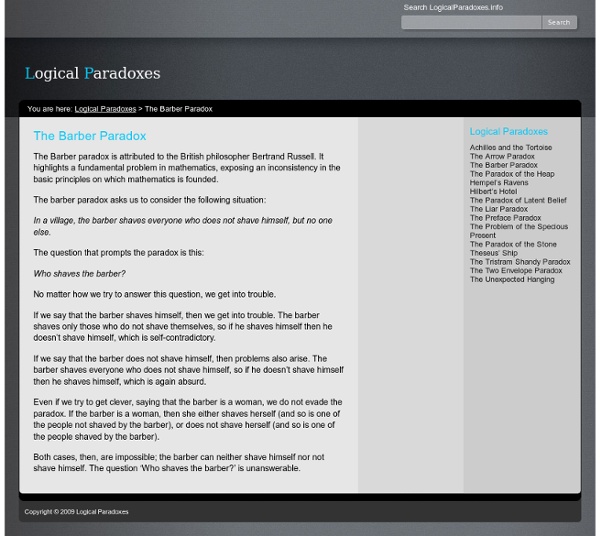Logical Paradoxes » The Barber Paradox
The Barber paradox is attributed to the British philosopher Bertrand Russell. It highlights a fundamental problem in mathematics, exposing an inconsistency in the basic principles on which mathematics is founded. The barber paradox asks us to consider the following situation: In a village, the barber shaves everyone who does not shave himself, but no one else. The question that prompts the paradox is this: Who shaves the barber? No matter how we try to answer this question, we get into trouble. If we say that the barber shaves himself, then we get into trouble. If we say that the barber does not shave himself, then problems also arise. Even if we try to get clever, saying that the barber is a woman, we do not evade the paradox. Both cases, then, are impossible; the barber can neither shave himself nor not shave himself.
Complexity Science for the Real World (CSRW)
Logical Paradoxes
Human Complexity 2012
1st Annual Conference on Complexity and Human Experience Modeling Complexity in the Humanities and Social Sciences May 30th - June 1st, 2012 The University of North Carolina at Charlotte The recent increase in the number of formal institutes and conferences dedicated to complexity theory and its application is evidence that complexity science has arrived and is realizing its potential to cut across almost every academic discipline. The conference series will be dedicated to a particular topic each year. Submissions are invited on any specific topic that falls within the parameters described above. Submission Guidelines Submissions should be in the form of 5000-word papers, each of which will be reviewed by the program committee. Submissions can be made through the EasyChair Conference system. This conference is dedicated to the work of Alan Turing (1912-1954) as part of the 2012 Alan Turing Year, a series of events to commemorate Turing's life and work.
The Hardest Logic Puzzle Ever
The Hardest Logic Puzzle Ever is a logic puzzle invented by American philosopher and logician George Boolos and published in The Harvard Review of Philosophy in 1996. A translation in Italian was published earlier in the newspaper La Repubblica, under the title L'indovinello più difficile del mondo. The puzzle is inspired by Raymond Smullyan. It is stated as follows: Three gods A, B, and C are called, in no particular order, True, False, and Random. Boolos provides the following clarifications:[1] a single god may be asked more than one question, questions are permitted to depend on the answers to earlier questions, and the nature of Random's response should be thought of as depending on the flip of a coin hidden in his brain: if the coin comes down heads, he speaks truly; if tails, falsely.[2] History[edit] The solution[edit] Boolos provided his solution in the same article in which he introduced the puzzle. Boolos' question was to ask A: Equivalently: If I asked you Q, would you say ja?
Irresistible force paradox
The irresistible force paradox, also called the unstoppable force paradox, is a classic paradox formulated as "What happens when an unstoppable force meets an immovable object?" This paradox is a form of the omnipotence paradox, which is a simple demonstration that challenges omnipotence: ("Can God create a stone so heavy that not even God is strong enough to lift it?"). The immovable object and the irresistible force are both implicitly assumed to be indestructible, or else the question would have a trivial resolution ("it destroys it"). Furthermore, it is assumed that they are two separate entities, since an irresistible force is implicitly an immovable object, and vice versa. The paradox arises because it rests on two premises—that there exist such things as irresistible forces and immovable objects—which cannot both be true at once. If there exists an irresistible force, it follows logically that there cannot be any such thing as an immovable object, and vice versa.[1] Origins[edit]
Related:
Related:



